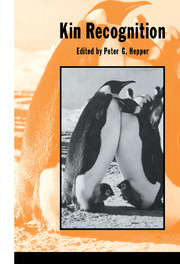Book contents
- Frontmatter
- Contents
- List of contributors
- Preface
- Introduction
- 1 The correlation between kinship and behaviour in non-human primates
- 2 Co-operation and reciprocity in birds and mammals
- 3 Kinship and fellowship in ants and social wasps
- 4 Successes and failures of parent–offspring recognition in animals
- 5 Kinship, kin discrimination and mate choice
- 6 Genetic components of kin recognition in mammals
- 7 Kin recognition in amphibians
- 8 Kin recognition cues of vertebrates
- 9 Recognizing kin: ontogeny and classification
- 10 Parental states as mechanisms for kinship recognition and deception about relatedness
- 11 Fetal learning: implications for the development of kin recognition
- 12 Information processing and storage during filial imprinting
- 13 The honey bee as a model kin recognition system
- 14 Mutual mother–infant recognition in humans
- Author index
- Species and common name index
- Subject index
2 - Co-operation and reciprocity in birds and mammals
Published online by Cambridge University Press: 06 January 2010
- Frontmatter
- Contents
- List of contributors
- Preface
- Introduction
- 1 The correlation between kinship and behaviour in non-human primates
- 2 Co-operation and reciprocity in birds and mammals
- 3 Kinship and fellowship in ants and social wasps
- 4 Successes and failures of parent–offspring recognition in animals
- 5 Kinship, kin discrimination and mate choice
- 6 Genetic components of kin recognition in mammals
- 7 Kin recognition in amphibians
- 8 Kin recognition cues of vertebrates
- 9 Recognizing kin: ontogeny and classification
- 10 Parental states as mechanisms for kinship recognition and deception about relatedness
- 11 Fetal learning: implications for the development of kin recognition
- 12 Information processing and storage during filial imprinting
- 13 The honey bee as a model kin recognition system
- 14 Mutual mother–infant recognition in humans
- Author index
- Species and common name index
- Subject index
Summary
Co-operation can be defined as any mutually beneficial interaction between two or more individuals. By this standard definition, many, probably most, birds and mammals exhibit co-operation in one or more contexts. Cooperation can range from a simple apparently incidental group effect, such as the simultaneous mobbing of an owl by individuals of two species of songbirds, to complex mutual dependence, such as the rotating sentinel systems of some group-living animals (e.g. McGowan, 1987). Virtually all researchers recognize co-operation when they see it and its widespread occurrence is not a matter of controversy (Axelrod & Hamilton, 1981).
The phenomenon of co-operative behaviour is a fascinating one, for several reasons. First, co-operation is a universal human trait and the vast majority of interactions among individual humans are co-operative to a greater or lesser degree. Thus, it is easy for people to empathize with the cooperative behaviours they observe in animals.
Second, highly developed intra-group co-operation is often seen in species also characterized by high levels of inter-group competition. Our own species is the prime example of this relationship. Killing of conspecifics may be viewed as indicative of extreme intraspecific competition, and human warfare, the searching out and killing of male chimpanzees (Pan troglodytes) by groups of males (Goodall, 1986), the expulsion or killing of male prideholding lions, (Panthera leo) by invading coalitions of males (e.g. Packer & Pusey, 1982) and the running down and killing of a lone wolf (Canis lupis) by a pack (Mech, 1970), illustrate this relationship between co-operation and competition.
- Type
- Chapter
- Information
- Kin Recognition , pp. 30 - 59Publisher: Cambridge University PressPrint publication year: 1991
- 6
- Cited by



